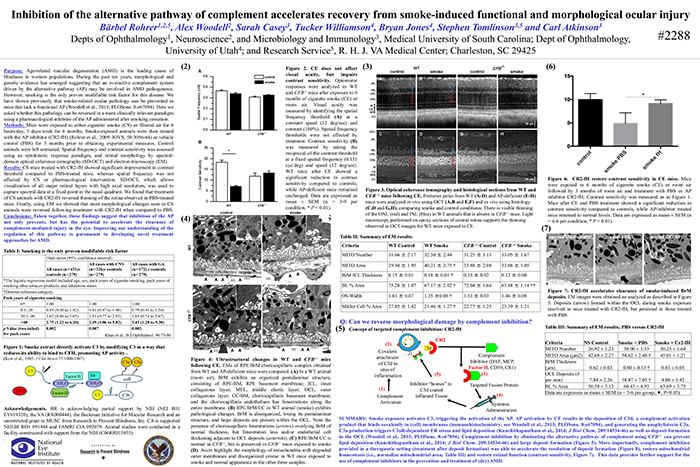This abstract was presented today, May 4th at the 2015 Association for Research in Vision and Opthalmology (ARVO) meetings in Denver, Colorado by Baerbel Rohrer, Alex Woodell, Sarah Casey, Tucker Williamson, myself, Stephen Tomlinson, and Carl Atkinson.
Purpose: Age-related macular degeneration (AMD) is the leading cause of blindness in western populations. During the past ten years, morphological and genetic evidence has emerged suggesting that an overactive complement system driven by the alternative pathway (AP) may be involved in AMD pathogenesis. However, smoking is the only proven modifiable risk factor for this disease. We have shown previously that smoke-related ocular pathology can be prevented in mice that lack a functional AP. Here we asked whether this pathology can be reversed in a more clinically relevant paradigm using a pharmacological inhibitor of the AP administered after smoking cessation.
Methods: Mice were exposed to either cigarette smoke (CS) or filtered air for 6 hours/day, 5 days/week for 6 months. Smoke-exposed animals were then treated with the AP inhibitor (CR2-fH) or vehicle control (PBS) for 3 months prior to obtaining experimental measures. Control animals were left untreated. Spatial frequency and contrast sensitivity was assessed using an optokinetic response paradigm, and retinal morphology by spectral-domain optical coherence tomography (SD-OCT) and electron microscopy (EM).
Results: CS mice treated with CR2-fH showed significant improvement in contrast threshold compared to PBS-treated mice, whereas spatial frequency was not affected by CS or pharmacological intervention. SD-OCT, which allows visualization of all major retinal layers with high axial resolution, was used to capture spectral data at a fixed point in the nasal quadrant. We found that treatment of CS animals with CR2-fH reversed thinning of the retina observed in PBS-treated mice. Finally, using EM we showed that most morphological changes seen in CS animals were reversed following treatment with CR2-fH when compared to PBS.
Conclusions: Taken together, these findings suggest that inhibition of the AP not only prevents, but has the potential to accelerate the clearance of complement-mediated injury in the eye. Improving our understanding of the regulation of this pathway is paramount to developing novel treatment approaches for AMD.
Layman Abstract: Age-related macular degeneration (AMD) is the leading cause of blindness in western populations. Two of the main risk factors for AMD are an overactive complement system driven by the alternative pathway (AP) and smoking. We have shown previously that smoke-related ocular pathology can be prevented in mice that lack a functional AP. Here we showed that this pathology can be reversed using a pharmacological inhibitor of the AP administered after smoking cessation, giving hope that therapeutics can be developed that reduce or reverse vision loss associated with AMD.

One Reply to “Inhibition Of The Alternative pathway Of Complement Accelerates Recovery From Smoke-Induced Functional And Morphological Ocular Injury”